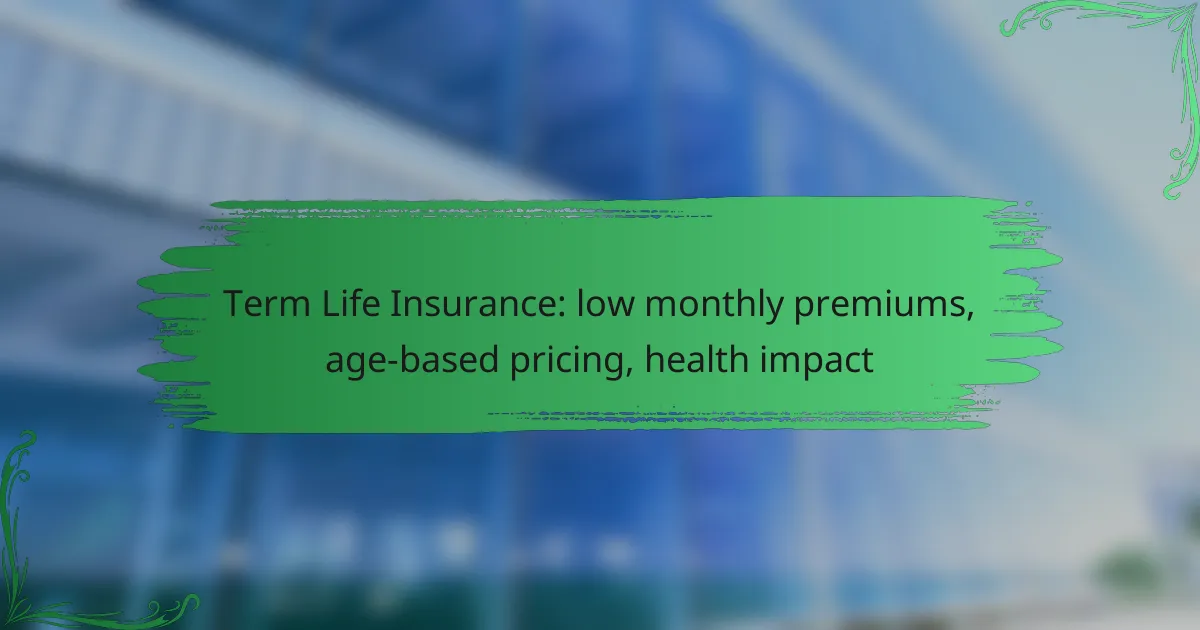Term life insurance offers an affordable way to secure financial protection for your loved ones, with low monthly premiums available through careful planning and comparison of providers. The pricing is largely age-based, meaning that premiums increase as you get older due to heightened health risks. Additionally, maintaining good health can lead to lower premiums, as insurers evaluate your health status when determining coverage costs.

How can I get low monthly premiums for term life insurance in the UK?
To secure low monthly premiums for term life insurance in the UK, focus on comparing providers, considering higher deductibles, and maintaining a healthy lifestyle. These strategies can significantly reduce costs while ensuring adequate coverage.
Comparison of providers
Different insurance companies offer varying rates for term life insurance, so it’s essential to compare multiple providers. Look for online comparison tools that allow you to evaluate premiums based on your age, health, and coverage needs. Some providers may have lower rates for specific demographics or health profiles.
When comparing, pay attention to the policy features as well as the premiums. Some insurers might offer additional benefits like terminal illness coverage or flexible payment options, which can add value to your policy.
Choosing a higher deductible
Opting for a higher deductible can lower your monthly premiums, as you agree to pay more out-of-pocket before the insurance kicks in. This approach is beneficial if you are in good health and unlikely to need to make a claim soon. However, ensure that the deductible is an amount you can comfortably afford in case of an emergency.
Evaluate your financial situation and risk tolerance before choosing a deductible. A higher deductible can save you money monthly, but it also means more financial responsibility if a claim arises.
Utilizing discounts for healthy lifestyles
Many insurers offer discounts for individuals who maintain a healthy lifestyle, such as non-smokers or those who regularly exercise. By providing evidence of your health habits, you may qualify for lower premiums. Some companies even offer wellness programs that reward healthy behaviors with premium reductions.
Consider getting regular health check-ups and maintaining a healthy weight, as these factors can positively influence your insurance rates. Always inquire about available discounts when obtaining quotes to ensure you maximize your savings.

What factors influence age-based pricing for term life insurance?
Age-based pricing for term life insurance is primarily influenced by the insured’s age at the time of application, which directly correlates with the risk of mortality. As individuals age, their premiums typically increase due to the higher likelihood of health issues and shorter life expectancy.
Age brackets and premium rates
Insurance companies categorize applicants into age brackets, often ranging from under 30 to over 60. Premium rates increase significantly as individuals move into older age groups, reflecting the increased risk of claims. For example, a 25-year-old might pay monthly premiums in the low tens of USD, while someone in their 50s could see rates rise to several hundred USD.
It’s essential to shop around, as different insurers may offer varying rates within the same age bracket. Comparing quotes can help identify the most cost-effective options for your age group.
Impact of life expectancy statistics
Life expectancy statistics play a crucial role in determining term life insurance premiums. Insurers analyze demographic data to assess the average lifespan of individuals within specific age groups, adjusting their pricing accordingly. For instance, if life expectancy in a certain region decreases, premiums may rise to account for the increased risk.
Understanding these statistics can help consumers make informed decisions. For example, if you are in good health and have a family history of longevity, you may be able to secure lower premiums even as you age. Regular health check-ups and maintaining a healthy lifestyle can also positively influence your premium rates.

How does health impact term life insurance premiums?
Health significantly influences term life insurance premiums, as insurers assess an applicant’s health status to determine risk. Generally, individuals in better health receive lower premiums, while those with pre-existing conditions may face higher costs or limited coverage options.
Health conditions and underwriting
During the underwriting process, insurers evaluate various health conditions to assess risk levels. Common conditions that can affect premiums include diabetes, heart disease, and obesity. For instance, a person with well-managed diabetes may pay lower premiums than someone with uncontrolled hypertension.
Insurers often categorize applicants based on their health history, lifestyle choices, and family medical background. Those with a clean bill of health and a healthy lifestyle typically qualify for the best rates, while individuals with serious health issues may find themselves in higher premium brackets.
Benefits of regular health check-ups
Regular health check-ups can lead to better health management and potentially lower life insurance premiums. By proactively addressing health issues, individuals can improve their overall health status, which insurers favor during the underwriting process.
Moreover, maintaining a record of regular check-ups can demonstrate to insurers that an applicant is committed to their health. This commitment may result in more favorable premium rates, especially if any health conditions are well-managed or resolved over time.

What are the prerequisites for obtaining term life insurance?
To obtain term life insurance, applicants typically need to meet certain prerequisites, including providing documentation and undergoing health assessments. These requirements help insurers evaluate risk and determine premium rates.
Required documentation
When applying for term life insurance, you will generally need to submit several key documents. These often include proof of identity, such as a driver’s license or passport, and financial information, like income statements or tax returns.
Additionally, some insurers may request information about your current debts and assets to assess your financial stability. Having these documents ready can streamline the application process and help you secure coverage more quickly.
Health assessments
Health assessments are a crucial part of obtaining term life insurance, as they allow insurers to evaluate your overall health and potential risk. This may involve a medical exam, which can include blood tests, urine tests, and measurements of height and weight.
Depending on your age and the coverage amount, insurers may also consider your medical history and any pre-existing conditions. Being honest and thorough in your health disclosures can help avoid complications later on, such as policy denial or higher premiums.

How do I choose the right term life insurance policy?
Choosing the right term life insurance policy involves assessing your coverage needs, understanding policy terms, and considering factors like age and health. Start by evaluating how much coverage you require and familiarize yourself with the different options available.
Evaluating coverage needs
To evaluate your coverage needs, consider your financial obligations, such as mortgage payments, education costs, and daily living expenses. A common rule of thumb is to aim for coverage that is 10 to 15 times your annual income, but personal circumstances may require adjustments.
Additionally, think about the duration of coverage you need. If you have young children, a longer term may be appropriate to ensure their financial security until they are independent. Review your current and future financial responsibilities to determine the right amount and length of coverage.
Understanding policy terms
Understanding the terms of a term life insurance policy is crucial for making an informed decision. Key elements include the length of the term, premium costs, and the death benefit amount. Premiums typically increase with age, so locking in a policy at a younger age can result in lower monthly payments.
Be aware of the renewal options and whether the policy is convertible to a permanent policy later on. Read the fine print for exclusions and limitations, as these can significantly impact your coverage. Always compare multiple policies to find the best fit for your needs and budget.

What are the common misconceptions about term life insurance?
Many people misunderstand term life insurance, often believing it offers more benefits than it actually does. Common misconceptions include confusion about coverage duration and the renewability of policies, which can lead to unrealistic expectations.
Misunderstanding coverage duration
One prevalent misconception is that term life insurance provides lifelong coverage. In reality, term policies are designed to last for a specific period, typically ranging from 10 to 30 years. Once the term expires, the coverage ends, and the policyholder may not receive any payout if they pass away after this period.
It’s essential to choose a term length that aligns with your financial responsibilities, such as raising children or paying off a mortgage. If you need coverage beyond the term, you may need to purchase a new policy, which could come at a higher premium due to age or health changes.
Beliefs about renewability
Another common belief is that all term life insurance policies are easily renewable. While many policies do offer a renewal option, it often comes with increased premiums based on the insured’s age at the time of renewal. This can lead to significantly higher costs compared to the original premium.
Before purchasing a term policy, check the terms regarding renewability. Some policies may allow for guaranteed renewals without a medical exam, while others might require underwriting, which could affect your eligibility or premium rates.

What are the emerging trends in term life insurance in the UK?
Emerging trends in term life insurance in the UK focus on low monthly premiums, age-based pricing, and the impact of health on policy costs. Insurers are increasingly tailoring products to meet the diverse needs of consumers while maintaining affordability and accessibility.
Low monthly premiums
Low monthly premiums are a significant trend in the UK term life insurance market, making coverage more accessible to a broader audience. Insurers are competing to offer attractive rates, often resulting in policies that can start from as little as £5 to £10 per month for younger, healthier applicants.
To secure the best rates, it’s advisable to compare multiple providers and consider factors such as coverage amount and policy length. Additionally, opting for a policy without add-ons can help keep premiums low.
Age-based pricing
Age-based pricing is a crucial factor in determining term life insurance premiums, with younger applicants generally enjoying lower rates. Insurers assess the risk associated with age, as older individuals are statistically more likely to file claims, leading to higher premiums.
When considering a policy, it’s beneficial to purchase term life insurance at a younger age to lock in lower rates. This strategy can result in substantial savings over the life of the policy, especially for those in good health.
Health impact
The health of an applicant significantly influences term life insurance premiums in the UK. Insurers evaluate medical history, lifestyle choices, and current health conditions to determine risk levels, which can lead to varying premium costs.
To mitigate health-related premium increases, individuals should maintain a healthy lifestyle, manage chronic conditions, and consider undergoing a medical examination if required. Being proactive about health can lead to more favorable insurance terms and lower costs.



